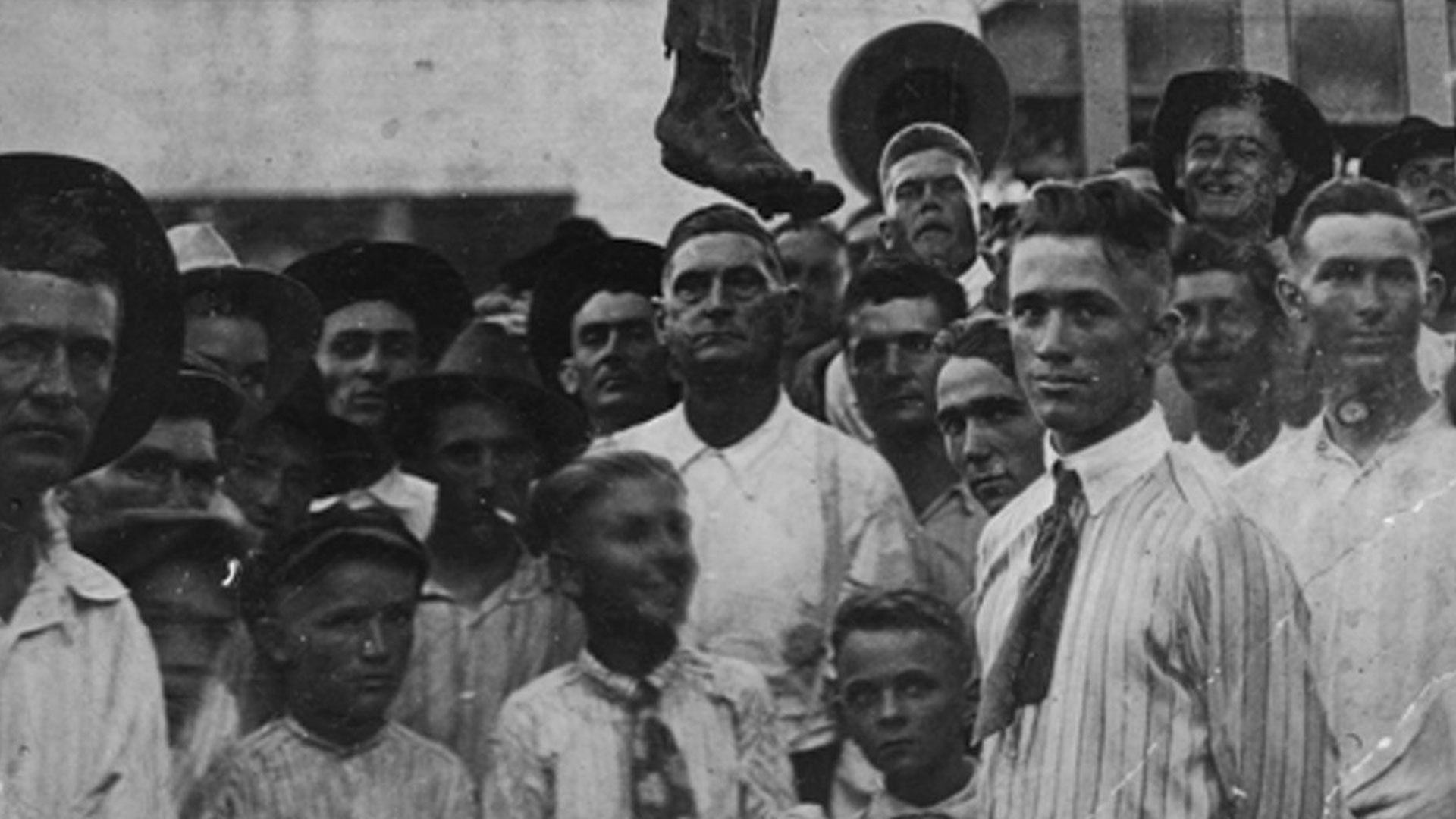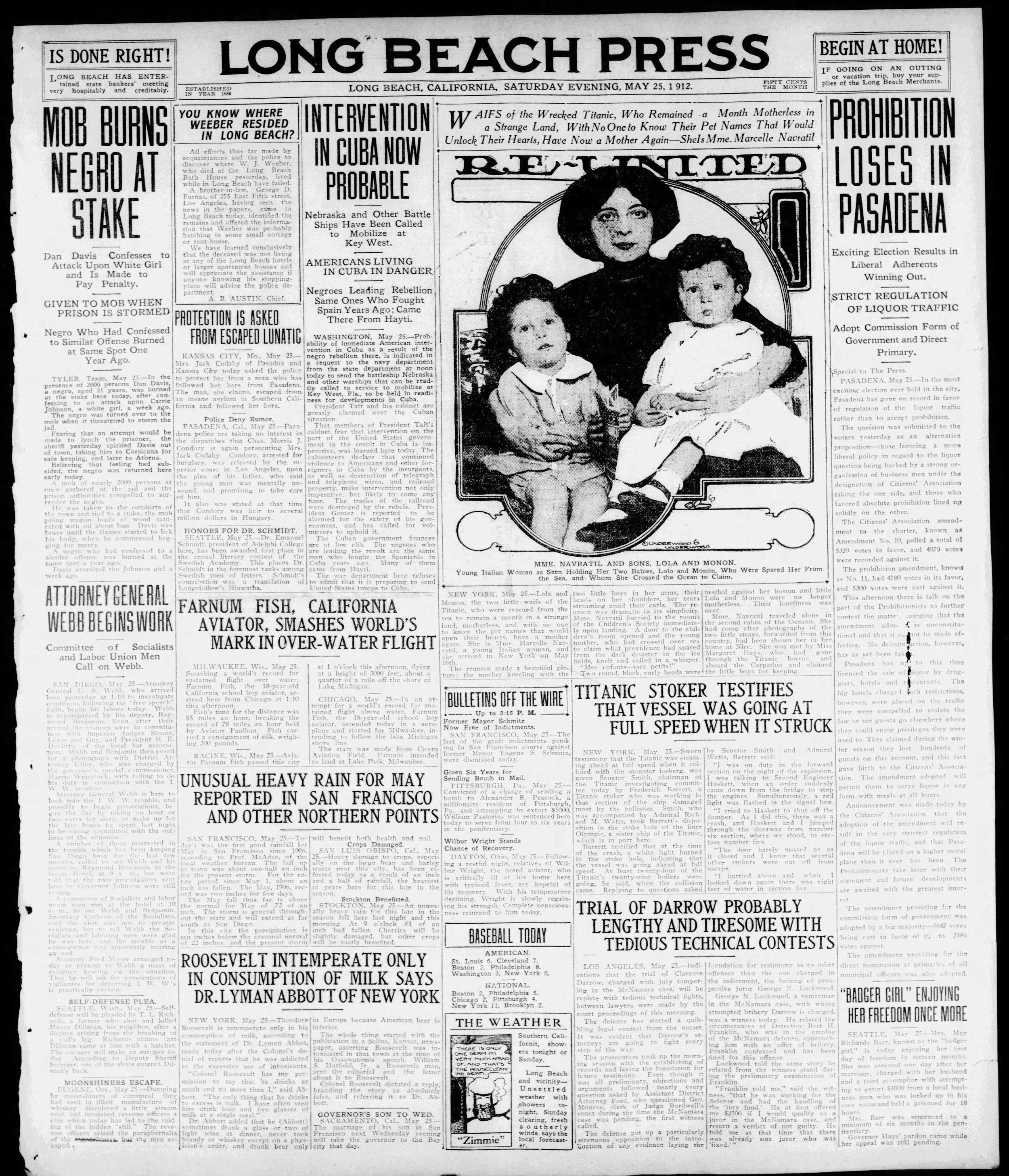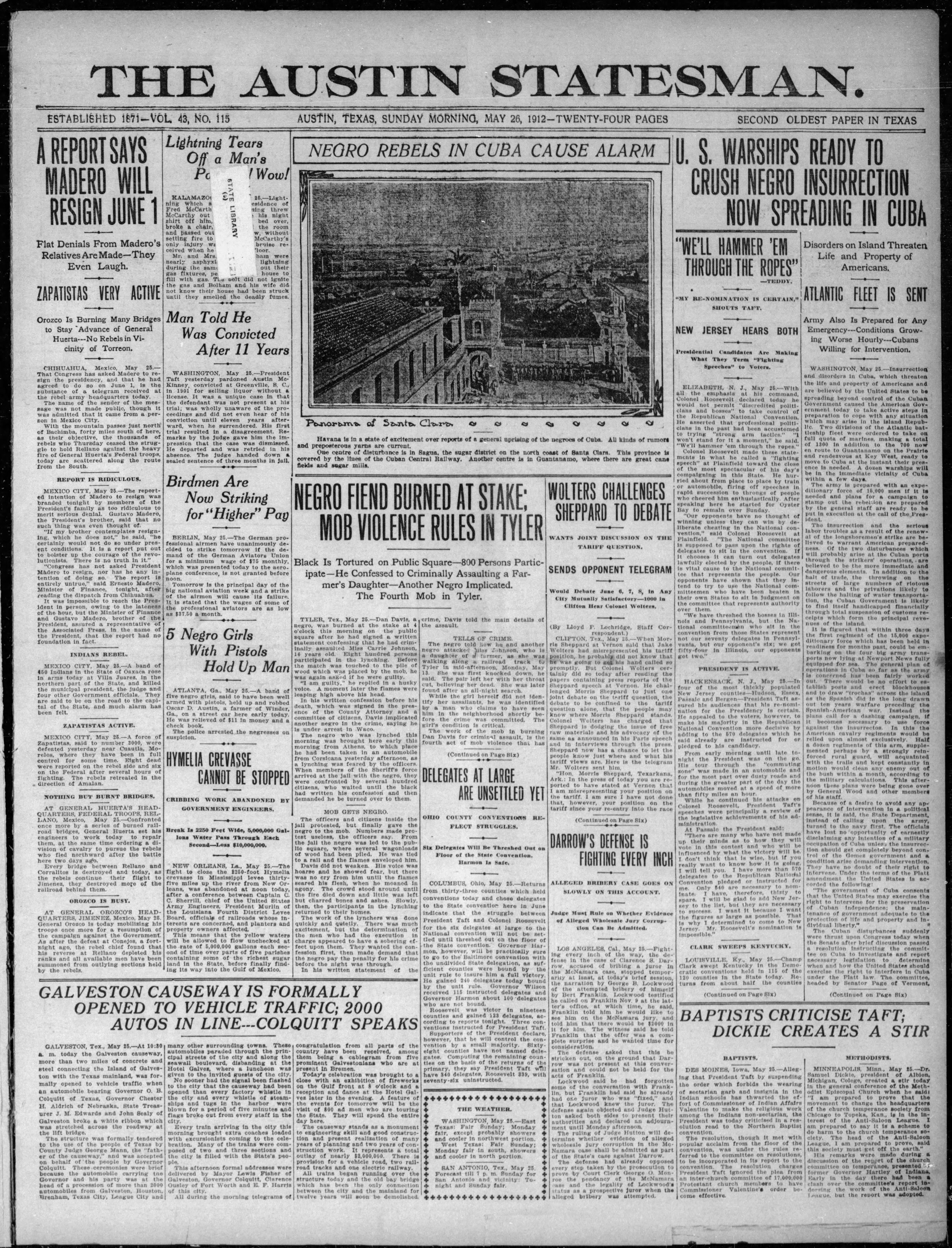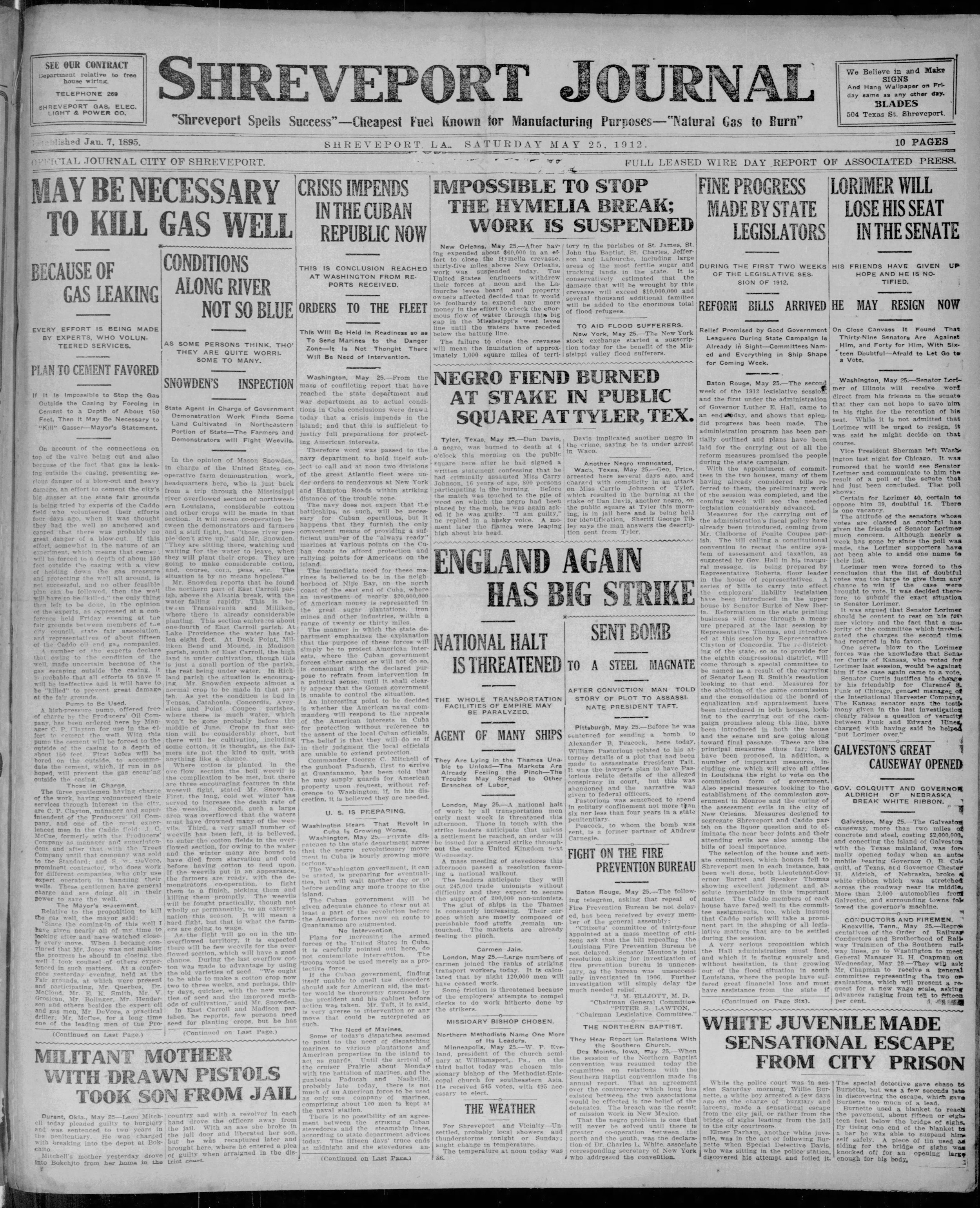Upwards of 2,000 Lynch Negro On A Rail Outside Smith County Jail
1912 - WE REMEMBER DAN DAVIS
The Lynching of Dan Davis
The Inferno of Injustice: A Legacy of Blood-Stained Shadows
In the annals of Tyler's history, a chilling chapter unfolded on that fateful day after Dan Davis was mercilessly lynched, his agony echoing far beyond the boundaries of Tyler. Headlines from the Dubuque Times Journal to the Middletown Daily Times Press splashed across the pages, revealing the grotesque spectacle of a "Negro Fiend Burned At Stake," while the sinister subtitle unveiled the horrors within—800 individuals participating, a false confession extracted, and a city plagued by its fourth mob. The N.A.A.C.P., too, bore witness to the violence, an indelible stain on the collective conscience.
Children Laughing At A Lynching In Center, Texas
May 25, 1912, was etched into the darkest corners of memory, as Dan Davis became the third African American man to be consumed by the flames of hatred, right in the heart of downtown Tyler. Yet, the details of this brutal episode failed to support any semblance of guilt for a crime committed.
The genesis of this tragedy lay in the harrowing assault on sixteen-year-old Carrie Johnson, a young white girl, along the railroad tracks leading into Tyler. Although Johnson survived the attack, she bore the scars—missing teeth, a fractured skull, and a throat slashed open, bleeding. Amidst the chaos, a stranger's account of a Black man in the vicinity took hold, even though Johnson herself could not identify her assailant.
With scant information to form a meaningful description, a Tyler police officer took it upon himself to create a handbill, hastily disseminated throughout Texas. It was this handbill that found its way into the hands of Henry Burch, a farmer from Powell, a community over 60 miles away. Blinded by prejudice, Burch saw a resemblance between Dan Davis, who had been laboring for him, and the vague description. Fuelled by his conviction, Burch enlisted the aid of a few accomplices to abduct Davis, subsequently contacting Tyler officials. They convened in Athens, the nearest town to the Burch farm, setting the stage for an unfathomable chain of events.
Seventy-five Tylerites swiftly descended upon Athens via a train, where Davis was surrendered to local authorities, only to be confronted by the Tyler mob accompanied by two hundred enraged locals, demanding his return to Tyler. Amidst assurances that Davis would remain unharmed, Athens authorities relinquished their hold on him. Eighty individuals from Athens joined the mob's journey back to Tyler, where the enraged crowd awaited their arrival, 1,000 strong at the train depot, while another throng gathered on the square. The Tyler Police Department implored the mob to withhold their actions until a positive identification was made by Johnson. For a fleeting moment, there was a hint of restraint, but it quickly evaporated as Davis was interrogated. Under relentless pressure, he broke, implicating an alleged accomplice, George A. Price, already incarcerated in a Waco jail. With the dubious "confession" in hand, the mob dispensed with the need for Johnson's identification, swiftly organizing the ghastly spectacle that awaited Davis.
Despite feeble objections from the Tyler Police Department, the demands of the mob prevailed. Davis was dragged outside, bound to a steel rail, while kindling, hay, and tinder were assembled beneath his feet. Davis, consumed by agony, cried out his coerced confession once more as the flames roared to life. Amidst the searing blaze, he pleaded for an act of mercy, begging anyone who possessed a shred of humanity to end his suffering by slicing his throat. Silence engulfed the scene—no one answered his desperate plea. As Davis's body turned to charred remnants, the excitement waned, the mob dispersed, and darkness descended.
Within this harrowing tale, justice remains an elusive specter, vanishing amidst the charred remnants of humanity. No trial, no semblance of fairness—only a coerced confession extracted under the weight of duress, staining the very fabric of truth.
A horde of vigilantes, numbering in the hundreds, journeyed to Waco in pursuit of Davis' alleged accomplice, Mr. Price. Unbeknownst to these self-proclaimed guardians of justice, Athens officials had cunningly disseminated false information, claiming that Price had been safely transferred to the Rusk County jail. However, hidden from their vengeful gazes, McLennan County Deputy Sheriff Phil Hobbs orchestrated Price's secret transport to the confines of the Bexar County jail in San Antonio. Price was later released., his indictment in Smith County was surprisingly no-billed by the Tyler grand jury. Price later vanished into the shadows, leaving behind a community haunted by the echoes of its own injustice.
The September 1912 issue of The Crisis devoted a page to Davis lynching. Below you will find the full text of the article that offers a unique perspective.
“Race, rather than the alleged offense, sealed lynching victims’ fates. Lynching, a statement of racial terror and white supremacy, was largely reserved for Black suspects. White people accused of murder or rape during this era were much more likely to be tried, convicted, and punished by the legal system than by a mob.”
AUTO-DA-FE IN TYLER, TEXAS
”There was some disappointment in the crowd and criticism of those who had bossed the arrangements because the fire was so slow in reaching the Negro. It was really only ten minutes after the fire was started before smoking shoe soles and a twitching of the Negro’s feet indicated that his lower extremities were burning, but the time seemed much longer. The spectators had waited so long to see him tortured that they begrudged the ten minutes additional before his suffering really began.
”The Negro had uttered but few words. When he was led to where he was to be burned, he said quite calmly: “I wish some of you gentlemen would be Christian enough to cut my throat,” but nobody responded.
”When the fire was started, he screamed: “Lord, have mercy on my soul,” and that was the last he spoke, though he was conscious for fully twenty minutes after that! His exhibition of nerve aroused the admiration even of his torturers.
”A slight hitch in the proceedings occurred when the Negro was about half burned. His clothing had all been stripped off and burned to ashes by the flames, and his black body hung nude in the gray dawn light. The flesh had been burned from his legs as high as the knees when it was seen that the wood supply was running short.
”There was a call for volunteers to go after more wood, but there were no responses. None of the men or boys were willing to miss an incident of the torture. All feared something of more than usual interest might happen, and it would be embarrassing to admit later on, not having seen it on account of being absent after more wood.
”Something had to be done, however, and a few men from the edge of the crowd ran after more dry-goods boxes, and by reason of this “public service” gained standing room in the inner circle after having delivered the fuel.
”Meanwhile, the crowd jeered the dying man and uttered shocking comments suggestive of a cannibalistic spirit. Some danced and sang to testify to their enjoyment of the occasion.






